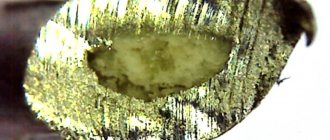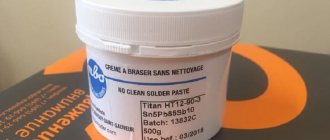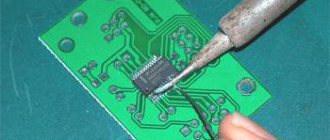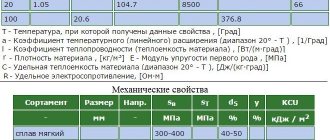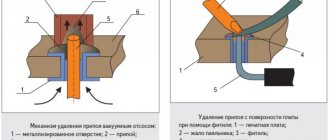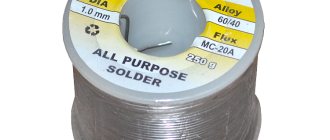Copper pipes are often used to organize plumbing systems. In addition, such elements are often used when decorating residential premises in the steampunk style. Regardless of the purpose of using such elements, copper pipes must be somehow connected to each other. The easiest way to do this is with copper-phosphorus solder. In this case, the joint will be neat and airtight. After the seams harden, the structure will be as strong as a solid pipe. However, before you start soldering with copper-phosphorus solder, it is worth knowing some of the characteristics of the material you are going to work with.
Useful information about copper
The soft metal alloy began to be used in ancient times for minting coins.
Today this material has become a little less popular, but heating and plumbing systems made from copper pipes are still the most durable, reliable and durable. Installation of such lines is carried out using soldering. During the work process, metal elements are connected to solder - a specially selected material, the melting point of which should be lower than that of the workpiece.
The soldering process itself is simple. The main thing is to choose the right connecting material. In our case, this is copper-phosphorus solder. It is also worth deciding on the soldering method. There are several of them.
The soldering process itself is simple. The main thing is to choose the right connecting material. In our case, this is copper-phosphorus solder. It is also worth deciding on the soldering method. There are several of them.
Methods
There are two ways to independently connect a copper pipe line:
- Low temperature. This method is the simplest and most commonly used at home. In this case, soft solder is used from tin, lead or alloys of these metals with the addition of some silver. During low-temperature processing, the melting point of copper-phosphorus solder is no more than 450 degrees.
- High temperature (solid). Such soldering is quite difficult and expensive to organize at home, since in this case the melting temperature of the material should be from 600 to 900 degrees.
There are two main methods of soldering copper blanks:
- High temperature. Silver or copper based refractory solder creates a rigid and durable connection. The seam is called solid and can withstand mechanical and temperature loads. To prevent annealing from leading to a deterioration in the strength of the main parts, the finished soldering should be cooled exclusively naturally, without blowing with cold air or immersing it in liquid.
- Low temperature. This type of soldering is called soft soldering. Solders are prepared on the basis of metals with low melting points. The low temperature avoids annealing and there is no reduction in the strength of the pipes. The method forms seams with a width of 7 to 50 mm, on pipes from 6 to 100 mm in diameter.
Soft connections cannot be used when installing gas pipelines.
For soldering you will need:
- flux for surface treatment of the workpiece;
- solder corresponding to the selected soldering method;
- device for chamfering the end of a pipe;
- wire brush and brush for cleaning workpieces;
- pipe expander;
- measuring instrument: tape measure, measuring gauge, square, spirit level;
- burner.
A portable propane torch makes it possible to heat a joint in a few seconds. In places where the use of an open flame is unacceptable, the joints are heated with an electric soldering iron with replaceable clamps and electrodes for different pipe diameters
Copper soldering methods
There are two ways to independently connect a copper pipe line:
- Low temperature. This method is the simplest and most commonly used at home. In this case, soft solder is used from tin, lead or alloys of these metals with the addition of some silver. During low-temperature processing, the melting point of copper-phosphorus solder is no more than 450 degrees.
- High temperature (solid). Such soldering is quite difficult and expensive to organize at home, since in this case the melting temperature of the material should be from 600 to 900 degrees.
What tools will you need?
To properly connect the highway, you must immediately prepare the following tools:
- Pipe cutter Without it, it will not be possible to cut the highway elements evenly. Using a pipe cutter you can make a perfect cut.
- Bevel remover. This tool is necessary for rounding and cleaning the edge of the cut pipe in order to ensure high-quality joining of parts.
- Pipe expander. If you plan to use couplings and fittings during the work, then thanks to this tool you can quickly expand a part of the pipe to the desired size.
- Brushes and brushes. After soldering, the pipes must be cleaned of oxide formations.
- Reflector. It is attached to the burner nozzle in order to direct the flame to a specific area. If you do not install the reflector, there is a risk of damaging surrounding objects.
- Gas-burner. With its help, copper-phosphorus solder is heated.
It’s worth talking about the last working tool in a little more detail.
Gas-burner
To ensure that the pipeline is properly welded, care must be taken to select the appropriate torch. The devices are:
- With disposable cylinders (household).
- With a stationary cylinder.
- Acetyl-oxygen.
The latter type is optimal for connecting copper pipes. This is exactly the kind of burner you need to buy.
The devices also differ in the strength of solder heating. The higher the heating temperature, the more powerful the device is needed. Respectively:
- For soft solder, a cheaper and less powerful torch is suitable. Therefore, you can safely purchase a semi-professional tool with a hot air gun. This burner is capable of reaching temperatures up to 650 degrees. The main advantage of such a tool is the ability to regulate the intensity of the flame. Thus, you can select the optimal melting temperature.
- For hard soldering you will need a professional tool, the cost of which will be several times higher. Therefore, there is no point in spending money on it, but if you really want it, then why not.
Before soldering pipes with copper-phosphorus solder, you need to purchase a material that will act as a binding component. Solder also comes in two types:
- Solid. This solder is made in the form of long rods. The composition of solid-type connecting materials Cu94 P6 and Cu92 P6 Ag2 includes a 6% addition of phosphorus, so the maximum permissible melting point is 750 degrees. Other types of solders do not contain substances that reduce the possible temperature treatment, so they can be heated up to 900 degrees. Carbide materials are most often used to connect gas supply, air conditioning and hot water supply pipes, as well as for the installation of pipelines operating at high pressure.
- Soft. Solder of this type is produced in the form of a thin wire, the diameter of which rarely exceeds 3 mm. Soft material is more suitable for use at home, when organizing water supply networks.
Additionally, it is recommended to purchase flux for copper-phosphorus solders. This paste-like substance, sold in cans, is necessary to quickly and effectively clean pipe joints. Flux removes oxide well from seams, due to which the characteristics of solder are significantly improved. In addition, this component enhances the adhesion of the solder and the copper surface.
The paste is available for soft and hard solder. Therefore, it is necessary to choose flux based on the chosen method of connecting pipes.
In addition to solder, torch and other tools, it is also recommended to prepare fittings. They will be needed if you have to make turns in the water main. These elements are inexpensive.
Copper-phosphorus solder HARRIS 5, length 500 mm, 1 pc.
Copper-phosphorus solder HARRIS 5, length 500 mm, 1 piece
+7 [email protected]
0 ₽
- Cart Checkout
- Your basket is empty!
- EVERYTHING FOR SOLDERING
- REFRACTORY SOLDER (above 450ºС)
Catalog
- TEXTOLITE, GLASS TEXTOLITE
- Textolite Textolite sheet
- Textolite rod
- Heat-resistant and heat-resistant materials Silica materials (-250°С - +1100°С) SILICA WOOL
- PTFE TEFLON TUBES (China)
- ALUMINUM TAPE
- TEFLON REINFORCED TAPE WITH PROTECTIVE BACKING
- Foam rubber
- PLEXIGLASS SHEETS
- Teflon PTFE tubes (China)
- CAPROLON SHEETS AND BARS
- Polyimide foil
- COMPOUNDS
- Ceramics-polymer heat-conducting insulating substrate KPTD-2/1
- PETV-2, PET-155
- MGTF, MGTF(E)
- Aluminum ALUMINUM CORNER
- Sheets, plates duralumin D16t
- BRONZE RIBBON
- BRASS TAPE
- COPPER TAPE
- STEEL - 45
- Cupronickel sheets
- Nickel silver sheets
- Titanium wire VT1-0
- PML, AMG
- Nichrome X20H80
- Cable RK 50
- RKGM
- BIN
- HEATING CABLE (METERS)
- Solder in rods
- HOT TOOL
- SOLDERING FLUXES (above 450ºC)
- POWER SUPPLIES
- FANS - COOLERS
- ROLLER, NEEDLE BEARINGS
- KEYS COMBINED KEYS
- RIVETS AND RIVETS
- KNIVES WITH SEGMENTED BLADES
- DIELECTRIC SCREWDRIVERS
- SIDE CUTTERS AND NIPPERS
- TOOL ORGANIZERS
- Drill sets, taps, dies, collets, chucks
- Breadboards and Jumpers
- VOLTMETERS, AMPERMETERS
- Aerosols Aerosols CRAMOLIN (Germany)
Information
- Contacts
- Shipping and payment
- Sale
Delivery across Russia
We will deliver your order by courier in Moscow or by express delivery service throughout Russia.
Tags
- ftp
- utp
- twisted pair
- dielectric
- insulating
- insulating material
- wire insulation
- transformer insulation
- control cable
- communication cable
Click on the image to view
Reviews: 0 / Write a review
Categories: REFRACTORY SOLDER (above 450ºС), ALL FOR SOLDERING
- Description
- Characteristics
- Reviews
Harris solders (USA) with silver content from 0% to 56% for high-quality high-temperature soldering of copper, brass, steel, iron and other metals. Copper-phosphorus solders with silver are more ductile and fusible; they are used for soldering copper products with closed joints.
Harris solders have a very high degree of chemical purity. They do not have oxidizing agents, both on the surface and inside the solder. High quality solders make the solder joint tight and durable. Joints brazed with Harris materials exceed the burst pressure of the pipe.
Harris solders do not contain cadmium!!! Often used cadmium-containing alloys emit fumes containing cadmium oxides during melting, which are toxic and can cause illness or death in workers. Harris solders are highly recommended as a replacement for all solders containing cadmium.
Harris solders are lead free!!! Harris soldering materials are specifically designed for potable water applications and can be used in the food industry without any restrictions.
We recommend watching
DRILL SET 1.0 - 1.9 (No. 7)
250 ₽
DRILL SET 0.6 - 1.0 (No. 4)
250 ₽
DRILL SET 0.6 - 1.5 (No. 5)
250 ₽
DRILL SET 0.8 - 1.2 (No. 6)
250 ₽
DRILL SET 0.4 - 1.3 (No. 3)
250 ₽
Customers who purchased copper-phosphorus solder HARRIS 5, length 500 mm, 1 pc. also bought
Heat-shrinkable adhesive tube 12.0/4.0 mm, black, 1 m
250 ₽
TESA Insulating tape Automotive FLEECE (interior, anti-creak, fabric, fabric) 0.3 x 19 mm, roll 25 m
400 ₽
PVC tube (CAMBRIC) Ø = 5.0 mm
300 ₽
Electric cardboard 0.5 x 200 x 300 mm
100 ₽
TESA Automotive electrical tape POLYESTER (under the hood, automobile, for the engine compartment) 0.3 x 19 mm, roll 25 m
500 ₽
Contact Information
- Moscow, Pyatnitskoe highway, 18 TK Mitinsky Radio Market, ground floor, pavilion “71 B” From 9-00 to 18-00, seven days a week
- +7
- +7, Write to WhatsApp
- [email protected]
Information
- About Store
- Privacy Policy
- Useful GOSTs
- Metal calculator
Applications
- home
- Blog
- Blog
© Cable-Garant. Electrical insulating materials. 2022
What properties does copper-phosphorus solder have, where is it used.
The basis of copper-phosphorus solder is copper, to which phosphorus is added as an additive. This solder perfectly connects copper parts without requiring a very high heating temperature of the product, since it melts at a temperature of 700–850 degrees. The exact melting point depends on the specific solder formula.
For example, a compound that contains copper and phosphorus in a ratio of 91%. 9%, melts at 800 degrees. And if the solder composition, in addition to copper and phosphorus, also includes tin and a small zinc content (ratio 89.5 (copper). 6 (phosphorus). 4 (tin). 0.5 (zinc)%), then melting begins at a temperature of 690 degrees C.
The most common brands of copper-phosphorus solder are PMF-7, PMF-9 and PMFOTsr-6-4-0.03. In the labeling of a compound, the number following the abbreviation indicating the composition indicates the percentage of phosphorus. PMFOTsr brand solder also includes tin and zirconium, which is indicated in its name with the letters O and Tsr, as well as numbers that indicate the amount of these additives (4 and 0.03%).
Copper-phosphorus solder for soldering copper: features
If we talk about this material, then it is worth paying attention to the fact that it has good fluidity. It can be used not only for copper, but also for its other alloys.
Since this material contains phosphorus, which is corrosion-resistant, there is no need to purchase additional flux.
Copper-phosphorus type solders are usually used to join elements in equipment subject to moderate vibration loads. If the joining material contains silver, the ductility of the components increases.
Soft soldering
Low-temperature soldering is suitable for installing a heating or water supply network if the temperature of the coolant does not exceed 130 degrees and the diameter of the copper pipes is no more than 10 cm.
To perform soldering you need:
- Clean the surfaces to be joined.
- Apply flux to them.
- Insert elements into each other.
- Heat the connection area with a burner to 200-250 degrees.
- Apply solder to the very edges of the parts.
- Constantly moving the burner, heat the connection for 15-20 seconds.
- When the flux darkens, you need to place a little more solder on the soldering area. As soon as the material is on the hot surface, it will immediately begin to melt and fill the space between the pipe and the socket.
Brazing
This method of connecting pipes is necessary if the operating temperature of the pipeline exceeds 110 degrees. In this case, soldering is performed using the gas-flame method and the working material is annealed.
When using solid material, there is no need to treat surfaces with flux.
To make a connection you must:
- Assemble and warm up the docking unit.
- Inject hard solder into the area where the socket and pipe connect to each other.
- Soften the material using a gas torch. It is necessary to ensure that the product does not overheat, so it is recommended to constantly move the burner.
- When the primary adhesion of the main line elements occurs, rotate the pipe and wind the molten solder onto the adjacent section.
This soldering method is more complicated than the previous one, but it has several advantages:
- The seams are stronger and more reliable.
- It becomes possible to slightly reduce the width of the joint, making the seam look neater.
In addition, this method is applicable when installing systems that operate at fairly high temperatures.
Soldering brass with copper-phosphorus solder is carried out using the same technologies.
Currently, there is such a method of joining metals as the use of hard solder, which is excellent for creating capillary and slot soldering, connecting copper pipes for water supply, installing gas pipelines and refrigeration equipment. This method allows you to form a reliable and high-quality connection while working with the attached materials.
Fluxes for working with hard solders
In many cases, it is impossible to carry out high-temperature soldering of copper products without fluxes. To clean the work area and prevent oxidation, several boron compounds are used: metaboric acid, boron oxide (acid anhydride), sodium tetraborate.
Manufacturers add calcium and potassium fluorides to fluxes intended for soldering steel alloys. Compositions of boric and hydrofluoric acids with the addition of potassium hydroxide can be used for soldering copper and various steel alloys.
The simplest flux for soldering copper at high temperatures is borax. It is universal in action, accessible, and has a low price.
Fluxes are sold in the form of solutions, loose powders, and solid pieces. Often, for convenience, flux is combined with solder. You can coat the solder rod on top and place a piece in the inner cavity of the rod.
In those rare cases when solder for working with copper is in powder form, it is combined (grinded if necessary) with dry flux.
Basic mistakes
During the work process, some people do not take into account defects on the surfaces of the elements being joined. Very often they appear after cutting pipes. If you leave these defects unattended, the seam will not be as reliable as it should be.
The flux must be applied evenly, without gaps. If it is not present in any section, the pipeline may begin to rust quite quickly.
If the pipe overheats too much, the flux paste will simply burn. This is also not very good.
During work, it is easy to get serious burns (not only from the burner flame, but also from contact with chemically active substances), so before starting soldering you must wear protective gloves, glasses and clothing.
Why do you need a tiny pocket on jeans? Everyone knows that there is a tiny pocket on jeans, but few have thought about why it might be needed. Interestingly, it was originally a place for storage.
Top 10 Broke Stars It turns out that sometimes even the biggest fame ends in failure, as is the case with these celebrities.
How to look younger: the best haircuts for those over 30, 40, 50, 60 Girls in their 20s don’t worry about the shape and length of their hair. It seems that youth is created for experiments with appearance and daring curls. However, already last.
Surprise: Husbands Want Their Wives to Do These 17 Things More Often If you want your relationship to be happier, you should do the things on this simple list more often.
9 Famous Women Who Have Fallen in Love with Women Showing interest in people other than the opposite sex is not unusual. You are unlikely to be able to surprise or shock anyone if you admit it.
11 Weird Signs That You're Good in Bed Do you also want to believe that you please your romantic partner in bed? At least you don't want to blush and apologize.
Beginner shareholders often make mistakes. The most typical of them are:
- Uncorrected surface defects after cutting: scoring, chips, out-of-roundness. Soldering over defects weakens the connection, reducing its durability and tightness.
- Poor quality degreasing.
- Narrowing of the installation gap. A narrow solder joint will also be unreliable.
- Underheating of workpieces. Cold parts will not be able to melt the solder with their heat and ensure its flow into the mounting gap. Cold solder joints can fall apart with a simple touch.
- Lack of flux paste. The part of the seam surface that is not covered with flux is not cleaned of the oxide film and is not soldered.
- Burnt joint. In this case, the flux burns out, the oxide film is not completely destroyed, and scale appears on the surface. Solder strength is significantly reduced.
- An attempt to test the strength of a hot joint. Leads to deformation of the solder layer in the mounting gap and its detachment from the parts.
Neglecting safety requirements is also a common mistake. High temperatures, harmful fumes, and chemically active fluxes require the use of personal protective equipment. These include:
- protective glasses;
- shoes, clothing and headwear made of non-flammable fabric;
- thick split leather gloves
- respirator.
There should be no flammable materials near the soldering area; it should be well ventilated. You cannot solder in the top position.
Correctly selected soldering composition allows you to obtain reliable and durable solder joints. It is equally important to use the appropriate flux and strictly adhere to the requirements of soldering technology and safety precautions.
How to choose?
If you want to purchase a copper-phosphorus filler material for soldering, then first of all you need to decide on its specific chemical composition. Basically, the choice is made between two broad groups, which differ from each other in the presence of silver in the composition.
Options with silver allow you to achieve higher strength for the final result of the connection than models without it. Also, models with silver should be used if the product operates at negative air temperatures. To do this, you need to purchase solder with a silver content of at least fifteen percent.
There is a rule that states that the thinner the metal, the lower the melting point of the filler material should be. In addition, the low melting point significantly increases the ability of the material to spread evenly over the working surface. It is worth noting that some models have fluxes of the same name; when used together, it is possible to achieve a high quality connection.
When soldering copper pipes, two main types are used:
- soft, with a melting point of up to 425°C;
- solid, with a temperature range of 460-560°C.
The use of silver-containing alloys is recommended as solders. They provide high quality connections, but are expensive. Copper-phosphorus compounds are more accessible and suitable for soldering less critical connections.
Copper-phosphorus
The melting point of copper-phosphorus solder is low. Copper solder allows you to do without flux compounds. The phosphorus contained in the composition will protect the work area from exposure to atmospheric oxygen.
The suture material, formed on the basis of copper-phosphorus solder, is very durable and resistant to vibration. Therefore, phosphorous compounds are widely used when soldering heat exchanger components.
Why do solders sometimes use copper solder when soldering steel parts, but copper cannot be soldered with steel solder? The reason is the difference in the melting temperatures of steel and copper. The copper blanks will already melt, but the steel will still heat up.
At the same time, copper-phosphorus solder is sensitive to overheating, so measures must be taken to cool the joint. The product is produced in the form of a rod. Copper soldering tape is also available. Copper-zinc low-temperature solders are also used for soldering.
Silver
Pure silver composition is not suitable for soldering copper products. They mainly use silver with the addition of iron, bismuth and other elements.
Silver-based copper solder has high wettability towards workpieces and penetrates perfectly into the narrowest gaps between them. The connections do not corrode and withstand large static and periodic dynamic loads.
Ag content
The chemical composition of solders for soldering copper and silver workpieces is described in GOST 19738-74. They are designated by the letters PSR XX, where the numbers determine the percentage of silver
Compositions with a high percentage of silver (50-72) have high electrical and thermal conductivity. They are used in electrical engineering and electronics.
Alloys with a medium percentage are cheaper and are used for soldering joints that are not subject to temperature stress.
Features of tinoles
A characteristic feature of silver-containing compounds is their low operating temperature. High fluidity allows the melt to penetrate into gaps and pores and create high-quality seams.
Brazing
Brazing alloys are used for joints of larger diameter tubes and pipelines. In this case, a paste-like flux, a gas burner for heating and the necessary auxiliary equipment and tools are used.
Low temperature
Low-temperature solders melt at temperatures up to 450°C. The low temperature avoids annealing of the base material of the pipe and preserves its physical and chemical properties. Solders are prepared on the basis of tin or zinc alloys. Lead is also used as a component.
High temperature
High-temperature solder for soldering copper is prepared on the basis of silver or copper, which has a high melting point. At temperatures above 450°C, the workpieces are annealed, leading to a decrease in their strength.
Silver solder.
Another common type of composition used for soldering copper is silver solder. As a rule, it is a combination of silver with copper and zinc. This composition can be used for soldering almost any metal. Its only drawback is that silver is too expensive. Therefore, silver solders are used only in cases where the economic feasibility of their use has been proven - for example, when particularly high demands are placed on the connecting seam.
Silver-based solders have no competitors in terms of wettability and spreading. They are also highly resistant to corrosion processes and can withstand shock loads and vibration.
The marking of such compositions contains the letters PSr (silver solders) and a number indicating the silver content in the substance. The more silver included in the composition, the higher the characteristics it has, but it is also more expensive. In practice, one of the most commonly used compositions is PSr-45, which contains 45% silver, as well as 30% copper and 25% zinc. This solder is capable of forming a connection with the highest quality and performance characteristics, therefore it is used for soldering in the most critical places of the product.
Note! In addition to copper and zinc, silver solder may also contain cadmium, which lowers the melting point of the substance to 250 degrees. But when using such solder, special precautions must be observed, since when it melts, cadmium vapors that are harmful to humans are released into the air.
Silver solders are most often produced in the form of rods or strips, the diameter of which is 2–3 mm. When soldering using silver compounds, a flux (most often borax) is used.
Copper pipes have gained popularity due to their high strength and easy machinability. They are installed in pipelines supplying gas and water, heating systems, air conditioners and refrigerators.
Copper does not oxidize in air, does not emit toxic substances, and helps destroy microorganisms. Many other products are made from copper, including wires, taps, door fittings, and jewelry. Soldering is used to repair or manufacture parts.
What properties does copper-phosphorus solder have, where is it used.
Properties depend on the chemical composition of the alloy. Thus, low-temperature ones have less strength, but do not reduce the strength and elastic characteristics of the material of the parts.
High-temperature ones, on the contrary, create high-strength joints that can withstand static and dynamic loads. But when using them, great care is required so as not to burn or weaken the base material.
The melting point of high-temperature compositions lies in the range of 645-815 ° C. The seam can withstand tensile loads up to 250 MPa. The operating temperature of the compound, depending on the composition, is 150-250°C. In addition to copper itself, such solders allow you to join brass, red bronze, cast iron, steel and nickel. They also solder aluminum. In addition, they are used to connect copper and stainless steel parts.
Silver solders
Such silver “tools” with a high percentage of silver up to 55% are used in high-temperature processes in the food industry using refrigeration equipment.
Specifics of silver tinoles
Low melting point and relatively good wetting of the material during soldering are the main advantages of silver solders. This material fills the gaps between the joined parts quite well, creating tight and vacuum seams. Such soldered seams are required for the installation and manufacture of refrigeration units. This tinol has a lower spreading temperature compared to other solder materials. This option allows the use of this solder during the processing of reinforcement parts of the system.
The types of silver tinoli are as follows:
- Type 1530 . A four-component substance with a percentage of silver within 30%. Quite inexpensive, has average spreading over the surface being finished, and fills gaps quite well. Used in various installed systems except food equipment due to the presence of harmful cadmium;
- Type 530Sn . Four-component material with a percentage of silver up to 30%. It has a high melting temperature, which is achieved using a gas burner. This creates an excellent solder seam no matter how the part is positioned. It's worth noting that it's not all positives;
- Type 538Sn . Four-component material with a silver percentage of up to 38%.
Technology
To cut pipe blanks, pipe cutters with manual or electric drive are used. To ensure an even cut, after each revolution the pressure-regulating flywheel should be tightened by a third of the stroke. The edge should be treated with a chamfer remover and cleaned with a brush. If the connection is butt, one of the pipes should be expanded. Next, the surfaces are degreased and the quality of their mating is checked.
Flux paste is applied to the inner surface with a brush built into the lid of the jar. It should be completely covered with flux, but at the same time no excess should accumulate on it.




